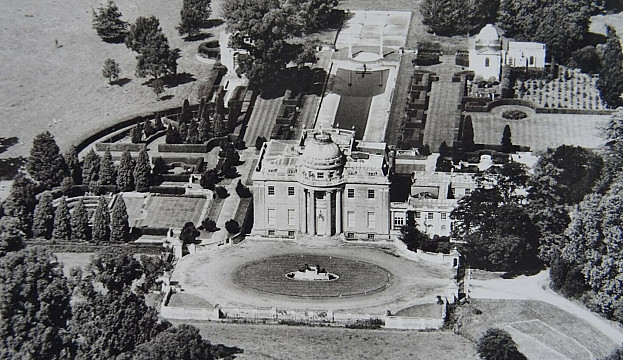Tyringham Hall
Newport Pagnell, Buckinghamshire

This house is best associated with...
Between 1907 and 1909, the Konigs commissioned Ernst Eberhard von Ihne to remodel the house. He was one of Berlin's best known architects, the architect to the German Emperor Frederick III, and a leading proponent of the Beaux-Arts-inspired Neo-Baroque style. It was Ernst von Ihne - not Charles Rees - who added Tyringham's distinctive Neo-Baroque copper-domed head over the portico which was a smaller version of the same he had added to the Bode Museum in Berlin in 1904. Not everyone admires it: one blogger, Matthew Beckett, compared it to being akin to putting, "a tea cosy on a champagne bottle”.
From 1911, the Konigs brought in another German architect, though in stark contrast to von Ihne, Charles G.F. Rees (born Carl Gottlob Friedrich Rees in Ludwigsburg) was almost entirely unknown. It was Rees who laid out the oval forecourt and Rose Garden. For their next significant round of works, the Konigs went back for a big name, and this time chose an Englishman: Between 1924 and 1928, Sir Edwin Landseer Lutyens designed the great axial garden on the north-west front which includes the Bathing Pavilion, the Temple of Music (that directly influenced his work in New Delhi, India), and the Pergola.
Mr Konig was a Jewish Theosophist and the Temple of Music, which features an organ in its crypt, was designed as a shrine to his humanist faith. If the copper-dome on the house has had its detractors, the Temple of Music is viewed entirely differently and at the time won a gold medal for its design. Mr Konig died shortly after the outbreak of World War II in 1940 and Tyringham was then one of three stately homes near London that were donated by their owners (in this case Mrs Konig) to serve as maternity hospitals.
After the war, Tyringham was purchased by the Australia and New Zealand Bank as a weekend club and from 1967 it became a private health clinic. In 2001, Tyringham and its 60-acres was bought up by property developer Anton Bilton whose wife, "Lisa B." comes from Brooklyn, New York, the neighboring borough to Queens where Mr Konig grew up. Having paid just £2.5 million, they proceeded to spend a further £10 million on extensive renovations before placing it on the market in 2013 with a price tag of £18 million.
You May Also Like...
Categories
Share
Connections
There are 2 members connected to this house, are you? Connect to record your link to this house. or just to show you love it! Connect to Tyringham Hall →
<private>'s ancestor, Frederick Adolphus Konig, owned Tyringham Hall
John Camp frequents Tyringham Hall









TERENCE BROWN
5 years agoDuring WW2, Tyringham Hall was used as a maternity hospital. The East London Maternity Hospital in Whitechapel was required for civilian casualties during the bombings of London Docks. Three stately homes around London were requisitioned to act as wartime maternity hospitals. Tyringham Hall was one of the three. I was born in the Hall in July 1941. My Christian name, Terry, was suggested by the Hall's name. My surname at that time was Lemon.
John Camp
4 years agoIn WW2 Tyringham Hall was used as a maternity hospital and I was born there on 22nd January 1941. My wife Carole Camp was also born there a few years later on 6th December 1944.
John Camp
4 years agoMy wife and I are very interested in knowing more about our Mothers experience in the house as they were young pregnant women,alone, far away from home and worried about their families left in war torn London. In January 1941 I could possibly be one of the first babies to have been born in the house.